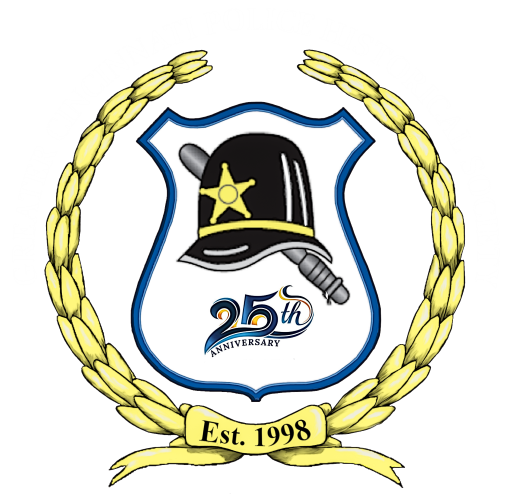Served as Cincinnati Patrolman, then
July 1869 to April 18, 1870, as Watchman
OFFICER
Uriah was a Civil War veteran and had served on the Cincinnati Police Department until, “due to the machinations of another of its members,” he was terminated. With a reputation as having a strong and honest character, he quickly found work as a night watchman for the Cincinnati Commercial Tribune and maintained a positive relationship with the members of the Cincinnati Police Department.
INCIDENT
On April 17, 1870, Cincinnati Patrolmen W. Matthew Keefer and William H. Auschutz found two ruffians, Jeremiah J. (Jerry) and George E. Lynch, making a disturbance at 3rd and Elm Streets. These two men were known to the officers to be involved in several fights and stabbings and the officers told them to leave the corner.
About 10:15 p.m., not knowing of this encounter, Watchman Sears, saw George Lynch on 4th Street as he was opening a pocket knife and concealing it up his sleeve. It was later determined by investigators that the brothers probably intended to coax Patrolmen Keefer and Auschutz into a pursuit and then ambush them. Though he lost his police job, he did not lose his police instinct, so Watchman Sears told Edwin W. Miller, with whom he was conversing, to go to the corner to advise Patrolmen Keefer and Auschutz that Lynch was out for mischief.
Watchman Sears followed Lynch. Miller, seeing that the Lynches would arrive before him, called a warning out to the patrolmen who then grabbed and searched George Lynch. By then, the knife had been closed, but they arrested him for Disorderly Conduct due to his drunkenness.
Watchman Sears returned to the Commercial Tribune building. Along the way Jerry Lynch confronted him in front of Lealle’s shirt store. He accused Watchman Sears of lying, struck him in the face, and ran across 4th Street with Watchman Sears in pursuit. Lynch appeared to slip and fall in front of Drown and Gibson’s carpet store at 4th and Race Streets; which was probably the plan to ambush the patrolmen. As soon as Watchman Sears caught up with him, Lynch sliced open Watchman Sears’s abdomen with a newly sharpened clasp knife.
Private Watchman Lincoln saw the whole affair and started in pursuit rapping his night stick for assistance and shouting directions to have him stopped. There were a few people on the streets, but they did not assist. Lynch ran down Race Street, to Baker Alley, to Vine Street, and back to 4th Street where he caught a street car at John Street. Police found the knife and Lynch’s hat near the site of the scuffle.
Watchman Sears, with great difficulty, walked back to the Commercial Tribune. Medical assistance was summoned, but the wound was such that it could not be dressed. He was taken to his home at 446½ George Street.
DEATH
By 3:15 a.m. on April 18, 1870, Watchman Sears’s physicians relinquished all hope for his recovery. At 11 a.m., Moses Wilson, Prosecuting Attorney, and Major Blackburn came to take his dying declaration, but by then he was unresponsive. He died at 12:17 p.m. in the presence of his grief-stricken wife begging him not to leave her.
Watchman Sears left a handicapped and destitute wife who was unable to work. None of their children survived him. His funeral took place from his residence on April 20, 1870. All the private watchmen in the city attended, as did a number of city policemen and representatives of nearly all the city’s Odd Fellow lodges. Rev. J.J. Thompson conducted the funeral service. He was buried at the Methodist burying ground at Cumminsville (now Wesleyan Cemetery).
A fund was established for Mrs. Sears. A number of men, fellow officers, and comrades in the Army led the effort. Many citizens responded and all sixty officers assigned to the Bremen Street Stationhouse contributed $1 (about $31 in 2020 dollars) each.
INVESTIGATION
Patrolmen Shiner and Keefer were detailed in plain clothes on the morning of the 18th to the Cincinnati, Hamilton, and Dayton Railroad Depot to assure Lynch did not escape via that route. About 6:30 a.m., they were advised that a man meeting Lynch’s description had been seen walking the tracks earlier in the morning. The officers caught the first train north which landed them in Lockland about 7:45 a.m. They did not find Lynch, so they continued north to Carthage where Lynch attempted to board the train and was promptly arrested about 8 a.m. After denying his part in the affair, Lynch admitted to stabbing the Watchman, but claimed self-defense. On searching him they found $15, a loaded revolver, and many cartridges. He was locked up in the 9th Street Station and charged with Cutting with Intent to Kill.
Also on the 18th, George Lynch was found guilty of Disorderly Conduct and sentenced to thirty days in the Work House.
The fate of Jerry Lynch is currently unknown. However, census records seem to indicate that he was in the Ohio Penitentiary in 1880 and in Montana by 1900 having served between ten and thirty years.
If you know of any information, archives, artifacts, or images regarding this officer or incident, please contact the Greater Cincinnati Police Museum at Memorial@Police-Museum.org.
© This narrative was revised October 3, 2011 by Cincinnati Police Lieutenant Stephen R. Kramer (Retired), Greater Cincinnati Police Historical Society President. All rights are reserved to him and the Greater Cincinnati Police Museum.


